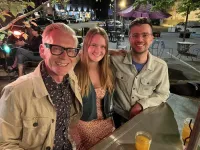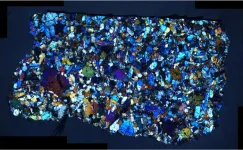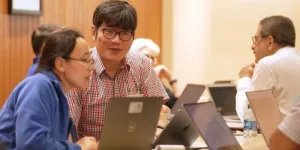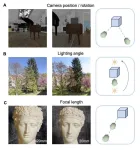(Press-News.org) Recently published research led by the University of Colorado Anschutz Medical Campus examined the prevalence — and impact — of physicians’ ethical or religious barriers to their involvement in medical aid in dying (MAiD), a multi-step process where a physician provides a terminally ill adult with decision-making capacity with a lethal dose of medication to end their life.
The research article, “Conscience-Based Barriers to Medical Aid in Dying: A Survey of Colorado Physicians,” was published this May in the Journal of General Internal Medicine. It shows that 26% of physician survey respondents reported large ethical and/or religious barriers to their involvement in MAiD.
Despite these barriers, the research suggests these conscience-based barriers do not appear to affect these physicians’ willingness to discuss medical aid in dying with their patients. However, they are much less likely to have any direct participation in it — being significantly less likely to serve as a consulting or attending physician — compared to physicians without these barriers.
Informing public policy
As legislators and health leaders across the nation continue to debate policies related to medical aid in dying, research like this is vital to making informed decisions.
“Medical aid in dying is under consideration in a number of states, and it comes up every legislative session. You cannot make policy around things that are not well understood, and so it was critical to gather data to better understand what's going on,” says Mika Hamer, PhD, MPH, the first author on the paper and a post-doctoral research fellow with the CU Center for Bioethics and Humanities. “It is important to look at the actual behaviors of physicians. This research offers essentially the first look into what is happening on the ground in a previously hidden and difficult-to-study population.”
For Hillary Lum, MD, PhD, a co-author of the paper and associate professor in the CU Division of Geriatric Medicine, getting involved in this research was important to her as a geriatrician and palliative medicine physician, given that questions about MAiD may arise when caring for older adults with serious illnesses.
“Medical aid-in-dying was legalized in 2016 in Colorado, but physician experiences providing care for patients seeking MAiD was under-studied,” Lum says.
A reason for the lack of data is because there are extensive protections in place for physician and patient privacy. As a result, the vast majority of data that exists are from qualitative studies or surveys of the general physician population.
“There is a long-standing debate around MAiD — the legality, the ethical appropriateness, the morality — and people have extremely strong opinions about it. But when we let those really strong opinions drive policy, rather than empirical data, we run the risk of implementing misguided policy that is more amenable to the cultural sentiment or social context at the time,” Hamer says.
To gather data about this important issue, researchers used anonymized, aggregate information on the 554 patients known to have received a MAiD prescription in Colorado from 2017 to 2020 and then identified the clinical conditions most prominent in this patient population. The research team then determined which physicians in Colorado were providing care to patients likely to qualify for MAiD based on their clinical conditions and sent them an anonymous survey regarding their willingness to provide MAiD and actual prior participation in MAiD. Ultimately, 300 physicians responded.
Since then, researchers have published several papers about the study, including: a scientific report about the research methodology; an analysis of physician’s attitudes and experiences; an examination of their perspectives on disclosure, presence, and eligibility; and the use and influence of medical aid in dying service on physician experiences.
“We felt there was an opportunity to look at this untapped aspect of the survey research. We had a hunch that there was something about ethical or religious barriers that may be different than other types of barriers physicians faced, like lack of time or fear of stigma,” Hamer says.
“We wanted to understand what these physicians have actually done when faced with these decisions, and we had a unique opportunity to measure that and lend some empirical data into what is a very contentious topic — but one that’s really quite understudied as far as hard data goes,” she adds.
Lum agrees with Hamer, saying: “In the absence of data, it’s easy to make assumptions — either that there are many physicians who have a conscientious objection to MAiD, or that there are few.”
“Thus, this study was important to actually measure the percentage of physicians who have a religious or ethical reason for not participating in MAiD activities,” Lum adds.
What the research shows
Out of the 300 survey respondents, 26% of physicians likely to care for MAiD-eligible patients in Colorado reported large ethical and/or religious barriers to participating in MAiD activities.
The survey also shows physicians with a longer time in practice and those identifying as non-white were more likely to report these conscience-based barriers.
Hamer said she was surprised that the survey data shows the physicians with these conscience-based barriers are still willing to participate in some aspects of the MAiD process. Specifically, when comparing physicians with and without these barriers, there was no difference in ancillary participation, meaning having discussions about MAiD or referring patients to other providers.
However, there were significant differences regarding direct participation in MAiD. To be eligible for MAiD, a patient must have decision-making capacity and a prognosis of less than six months to live. This prognosis must be independently verified by two physicians — an attending and consulting physician.
The survey found that only 5% of physicians with conscience-based barriers had served as a MAiD consultant, as compared to 31% of physicians without conscience-based barriers. When it came to serving as a MAiD attending, no physicians with conscience-based barriers had served in this role compared to 21% of physicians without these barriers.
“Participation looks different for different people. As far as consulting or attending, which are much more active roles that may involve writing prescriptions or doing evaluations — that’s where we start to see those barriers really show up in terms of changes in behavior,” Hamer says.
Lum says, “I think this emphasizes the importance of the relationship between physicians and patients. Whether a physician is willing to discuss, refer, serve as a consulting physician, or serve as a MAID attending physician is likely to vary. And there may be different reasons and situations related to the individual patient.”
Both Hamer and Lum noted that this study was limited in its sample size, highlighting the need for further research. With regard to conscience-based barriers, Hamer says it is important to distinguish that these “are not necessarily barriers to be overcome in the traditional sense of barriers.”
“We really see this as a space where physicians need accommodation — not intervention to help change their mind around this barrier,” Hamer says. “It calls for continued protection of physician rights to conscientiously object or not participate in a service to which they have deeply held, conflicting beliefs.”
There is also a need to better understand what support systems and processes need to be in place in clinics or hospitals to help support those physicians who have religious or ethical barriers. For instance, perhaps a formal referral process could be created so that physicians with these barriers can be involved in the beginning stages of MAiD, but when it comes to the more active roles, there is an established team the patient can be referred to.
“We must have protections in place and processes to support these physicians while ensuring patients are able to get the care they desire,” Hamer says. “It is something that needs to be considered especially as the legality of MAiD potentially expands. We need a balance between protecting physicians’ rights and preserving patient access.”
END
CU researchers analyze prevalence, impact of ethical or religious barriers to providing medical aid in dying
The recently published paper finds that 26% of physician respondents reported large ethical or religious barriers to participating in medical aid in dying, but many were still willing to engage in discussions with patients and provide referrals for care.
2024-05-31
ELSE PRESS RELEASES FROM THIS DATE:
Want to be a successful scientist? The McClements family has some tips
2024-05-31
The latest book of prolific author David Julian McClements is a family affair. The Distinguished Professor of Food Science, along with his daughter Isobelle Farrell McClements and nephew Jake McClements, have written “How to be a Successful Scientist: A Guide for Graduate Students, Postdocs, and Professors” (Springer, 2024).
The three authors offer different perspectives as scientists at different stages in their careers. Julian McClements, who has published more than 1,300 scientific articles and numerous books, is the most highly ...
Overcoming barriers to heat pump adoption in cold climates and avoiding the 'energy poverty trap'
2024-05-31
Converting home heating systems from natural gas furnaces to electric heat pumps is seen as a way to address climate change by reducing greenhouse gas emissions.
But a new University of Michigan study of 51 Southeast Michigan households shows that switching to efficient, cold-climate heat pumps would increase annual utility bills by an average of about $1,100.
Home weatherization upgrades, such as adding attic insulation and sealing around doors and windows, could help reduce utility bills and make ...
A new way to see viruses in action
2024-05-31
A new, nano-scale look at how the SARS-CoV-2 virus replicates in cells may offer greater precision in drug development, a Stanford University team reports in Nature Communications. Using advanced microscopy techniques, the researchers produced what might be some of the most crisp images available of the virus’s RNA and replication structures, which they witnessed form spherical shapes around the nucleus of the infected cell.
“We have not seen COVID infecting cells at this high resolution and known what we are looking at before,” said Stanley Qi, ...
Wealthier neighborhoods in Boulder saw lower bee diversity
2024-05-31
Community gardens in higher-income Boulder neighborhoods have fewer varieties of bees than their medium-income counterparts, new University of Colorado Boulder research suggests. Scientists suggest that people in these neighborhoods tend to apply more landscaping practices, such as using fertilizers, which could impact bees’ habitats.
The finding appeared May 22 in the journal Urban Ecosystems.
“Bees are so important for local ecosystems through their pollination services. The landscape would not look the same without our pollinators,” ...
Advancing excellence top priority for new board chair
2024-05-31
At its annual meeting on Thursday, the University of Miami Board of Trustees (BOT) confirmed Manuel “Manny” Kadre as its new chair, Wayne Chaplin and Bill Morrison as new vice chairs, and welcomed a slate of new trustees.
Kadre, chairman and chief executive officer of MBB Auto Group as well as a senior executive and shareholder of a number of beverage, automotive, health care, and real estate companies, first joined the board as a trustee in 2004. He served as a vice chair since June 2021 and more recently as board chair-elect.
“The University has one of the great reputations and brand names anywhere in the world,” ...
Martian meteorites deliver a trove of information on Red Planet’s structure
2024-05-31
Mars has a distinct structure in its mantle and crust with discernible reservoirs, and this is known thanks to meteorites that scientists at Scripps Institution of Oceanography at UC San Diego and colleagues have analyzed on Earth.
Meteorites that formed roughly 1.3 billion years ago and then ejected from Mars have been collected by scientists from sites in Antarctica and Africa in recent decades. Scripps Oceanography geologist James Day and his colleagues report May 31 in the journal Science Advances ...
Can ketones enhance cognitive function and protect brain networks?
2024-05-31
Researchers at the Del Monte Institute for Neuroscience at the University of Rochester have identified mechanisms in the brain’s hippocampal network that are rescued by ketones. These findings build on previous research showing that ketones can alleviate neurological and cognitive affects.
As we age our brain naturally becomes more insulin resistant. This creates a breakdown in communication between neurons, causing symptoms like changes in mood, cognitive decline, and eventually neurodegeneration. Nathan A. Smith, MS, PhD ('13), associate professor of Neuroscience, and fellow researchers studied the mechanisms in the brain that break down when insulin resistance is suddenly ...
AMS Science Preview: Sea-ice loss may accelerate; tornadoes and flying cars
2024-05-31
The American Meteorological Society continuously publishes research on climate, weather, and water in its 12 journals. Many of these articles are available for early online access–they are peer-reviewed, but not yet in their final published form.
Below is a selection of articles published early online recently. Some articles are open-access; to view others, members of the media can contact kpflaumer@ametsoc.org for press login credentials.
JOURNAL ARTICLES
Large-Scale Climate Modes Drive Low-Frequency Regional Arctic Sea Ice Variability
Journal of Climate
Arctic sea ice loss may accelerate in the coming decade. This study examined the dominant natural climate ...
UT Arlington, Microsoft host AI “Prompt-a-Thon”
2024-05-31
Faculty, staff and researchers from higher education and K-12 schools throughout Texas gathered in Arlington for the state’s first “Prompt-a-Thon” hosted by Microsoft and UTA’s offices of Research and Innovation and Information Technology. Together, educators and researchers learned how to best use artificial intelligence (AI) tools to improve their work.
“This Prompt-a-Thon is a significant step toward promoting AI literacy across multiple universities and establishing UTA as a frontrunner for AI use in the state,” said Jeremy Forsberg, associate ...
Children’s visual experience may hold key to better computer vision training
2024-05-31
UNIVERSITY PARK, Pa. — A novel, human-inspired approach to training artificial intelligence (AI) systems to identify objects and navigate their surroundings could set the stage for the development of more advanced AI systems to explore extreme environments or distant worlds, according to research from an interdisciplinary team at Penn State.
In the first two years of life, children experience a somewhat narrow set of objects and faces, but with many different viewpoints and under varying lighting conditions. Inspired by this developmental insight, the researchers introduced a new machine learning approach that uses information about spatial position to train AI visual ...
LAST 30 PRESS RELEASES:
Manta rays create mobile ecosystems, study finds
Study: Mixed results in using lipoic acid to treat progressive multiple sclerosis
Norbert Holtkamp appointed director of Fermi National Accelerator Laboratory
New agentic AI platform accelerates advanced optics design
Biologists discover neurons use physical signals — not electricity — to stabilize communication
Researchers discover that a hormone can access the brain by hitchhiking
University of Oklahoma researcher awarded funding to pursue AI-powered material design
Exploring how the visual system recovers following injury
Support for parents with infants at pediatric check-ups leads to better reading and math skills in elementary school
Kids’ behavioral health is a growing share of family health costs
Day & night: Cancer disrupts the brain’s natural rhythm
COVID-19 vaccination significantly reduces risk to pregnant women and baby
The role of vaccination in maternal and perinatal outcomes associated with COVID-19 in pregnancy
Mayo Clinic smartwatch system helps parents shorten and defuse children's severe tantrums early
Behavioral health spending spikes to 40% of all children’s health expenditures, nearly doubling in a decade
Digital cognitive behavioral treatment for generalized anxiety disorder
Expenditures for pediatric behavioral health care over time and estimated family financial burden
Air conditioning in nursing homes and mortality during extreme heat
The Alps to lose a record number of glaciers in the next decade
What makes a good proton conductor?
New science reporting guide published for journalists in Bulgaria
New international study reveals major survival gaps among children with cancer
New science reporting guide published for journalists in Turkey
Scientists develop a smarter mRNA therapy that knows which cells to target
Neuroanatomy-informed brain–machine hybrid intelligence for robust acoustic target detection
Eight SwRI hydrogen projects funded by ENERGYWERX
The Lundquist Institute and its start-up company Vitalex Biosciences Announces Strategic Advancement of Second-Generation fungal Vaccine VXV-01 through Phase 1 Trials under $40 Million Competitive Con
Fine particles in pollution are associated with early signs of autoimmune disease
Review article | Towards a Global Ground-Based Earth Observatory (GGBEO): Leveraging existing systems and networks
Penn and UMich create world’s smallest programmable, autonomous robots
[Press-News.org] CU researchers analyze prevalence, impact of ethical or religious barriers to providing medical aid in dyingThe recently published paper finds that 26% of physician respondents reported large ethical or religious barriers to participating in medical aid in dying, but many were still willing to engage in discussions with patients and provide referrals for care.






